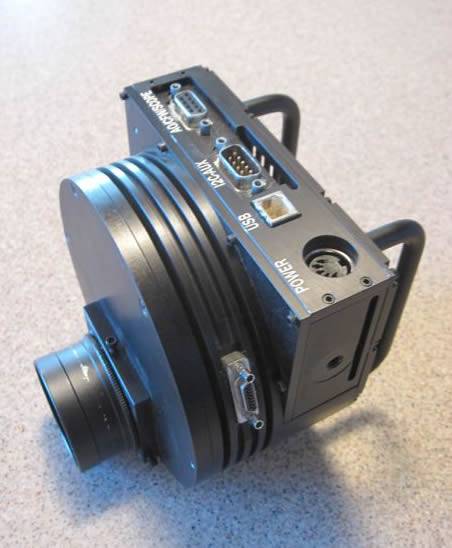
Starlight Express SVXF-M7C one-shot color Bayer matrix CCD camera for astro-imaging

The ST-4000XCM cooled astronomical CCD camera, manufactured by SBIG (Santa Barbara Instrument Group), is a medium-format (APS-size) one-shot color ("OSC") camera intended for long-exposure astronomical imaging. As of 2008-2009, this was SBIG's largest one-shot color camera, having 2000x2000 pixel resolution (i.e., 4 megapixels). One-shot color cameras are similar to their corresponding monochrome cameras (i.e., using the same CCD imaging chip), but incorporate a Bayer matrix of color filters over the CCD elements. The Bayer matrix is a scheme for obtaining color images from a single CCD by incorporating color filters in a specific RGB pattern over the entire chip. TheBayer matrix has an RGGB configuration, so there are one red and one blue pixel for every two green pixels. The resulting image as immediately displayed (e.g., in MaximDL or CCDSoft) is a monochrome image, but it can be easily converted to a color image with a click of one button. This allows immediate feedback as to the quality of a color image, without the usually laborious process of registering and stacking multiple RGB images (and usually, also a luminance image). The camera provides all of the data, and the software recreates the color image.
There are many trade-offs between monochrome cameras and one-shot color cameras: 1.) One-shot color cameras have lower effective resolution, as the pixels are divided among the different colors; software interpolates between pixels to create a high-resolution image 2.) One-shot color cameras have lower sensitivity compared to monochrome cameras - as the filters do not transmit 100% of the light (of course, neither do stand-alone filters) 3.) One-shot color cameras are much faster to use, if just taking a single-image "snapshot" - as there is no aligning or stacking to be done 4.) One-shot color cameras are NOT necessarily faster, in terms of exposure times, as the total exposure will still need to be long to bring out dim objects 5.) One-shot color cameras are not particularly suited to imaging red light - which is dominant in most nebula and other astronomical objects (as only 1 in 4 pixels will be receiving red light) 6.) One-shot color cameras are also not appropriate for taking Ha images (as again, only 1 in 4 pixels will respond, and perhaps with lower sensitivity due to the bandwith of the R filter)
Despite the limitations of one-shot color cameras (in terms of resolution and sensitivity), I would highly recommend one of these to astro-imagers moving up from a DSLR to a cooled astronomical camera. This is a giant step, which improves images by adding stabilized cooling, a guide chip, and provision for AO and other accessories. Cooling reduces the dark current, making the chip less noisy and thus requiring less image processing. Stabilization of the cooling makes it easier to subtrack Dark Frames from the astronomical image as part of the calibration; if both the image and thec"Darks" were taken at the same precise temperature, dark subtraction will work best. Also, despite points 5 and 6 above, one-shot cameras are being used to do great color and even narrowband (hydrogen alpha) work. Check out Mike Siniscalchi's direct comparison between the ST-2000XM (monochrome CCD camera) and ST-2000XCM (Bayer matrix one-shot color CCD camera) HERE.
|
This is the front of the camera, showing the usual 2" nosepiece (which goes into the focuser). I use an Optec dovetail, which screws onto the camera (with the nosepiece removed) and fits into the Pyxis rotator. The connector on the right side (of the round portion) is for the external (remote) guide head. | 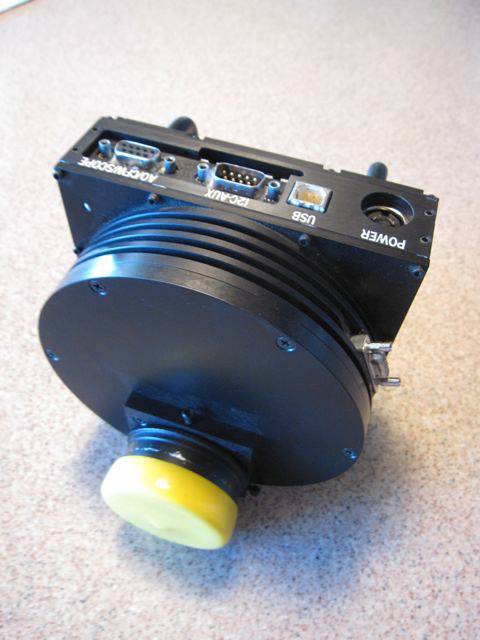 |
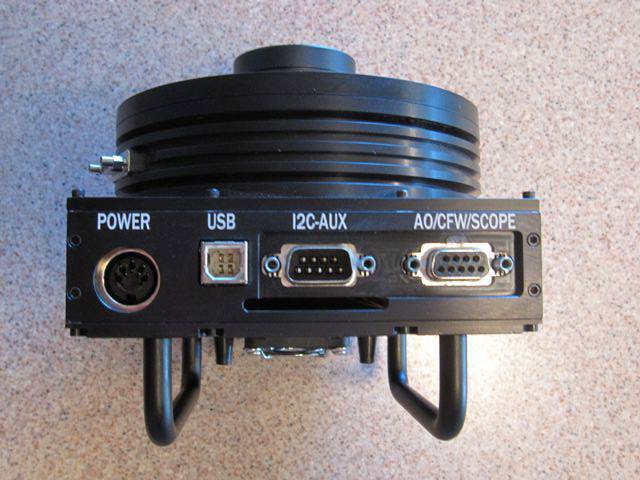 | Here, you can see the top of the camera with most of the electrical connectors - POWER (cable from SBIG power supply), USB (to computer for downloading images and controlling the camera), I2C-AUX (which connects to the AO unit), and SO/CFW/SCOPE (which connects to an external filter wheel). The handles on the back of the camera are removeable, but can be used for handling the camera, connecting a safety cable (in case the camera falls out of the focuser or rotator !!!), and makes a good place for cable ties for dressing the cables from the camera, so there is strain relief on the connectors. |
To the right are the specifications for the KAI-4022 chip provided by Kodak. The full brochure for the KAI-4022 (including some very detailed descriptions of how the chip works) can be found HERE. | 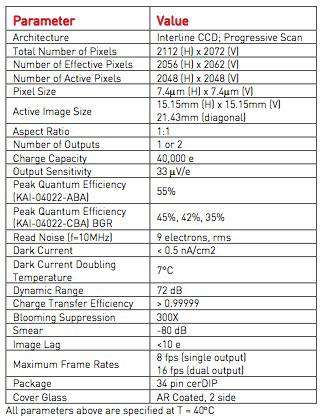 |
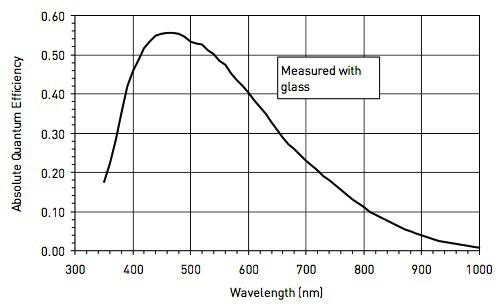 | The spectral sensivity of the chip (i.e., quantum efficiency vs. wavelength) is shown in the graph to the left. This is for the monochrome chip - i.e., without the Bayer color filter matrix overlayed. You can see that the peak QE is about 55%, but that the QE in the red (and Ha) end of the spectrum is closer to 30%. |
On the right, you can see the sensitivity curves for the three (R, G, B) filter bandwidths on the color version of the KAI-4022 chip. | 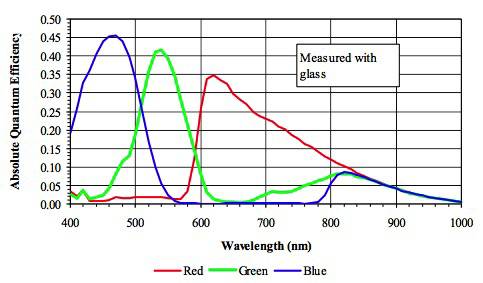 |
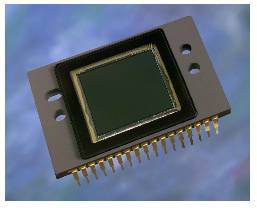 | To the left you can see a photo of the actual KAI-4022 chip, that is the heart of the SBIG ST-4000XCM camera. The camera, of course, incorporates all of the functions required to operate the chip, including thermo-electric ("TE") cooler, second chip for guiding, plumbing for water-cooling the heatsink, and all of the electronics to support both imaging chip and guide chip - plus the remote guide head, as well as connecting to the AO accessory and an external filter wheel. |
This is the AO-8 adaptive optics system that mounts to the ST-series cameras, and provides fast pointing corrections to the telescope (10-30 per second) over a narrow range (plus/minus 15 arcseconds) to both correct for tracking errors and to partially correct for atmospheric scintillation (twinkling of the star due to patches of different atmospheric conditions crossing through the line of site of the telescope, which slighly refracts the light, causing the position of the star to change - which will blur any long-exposure images). | 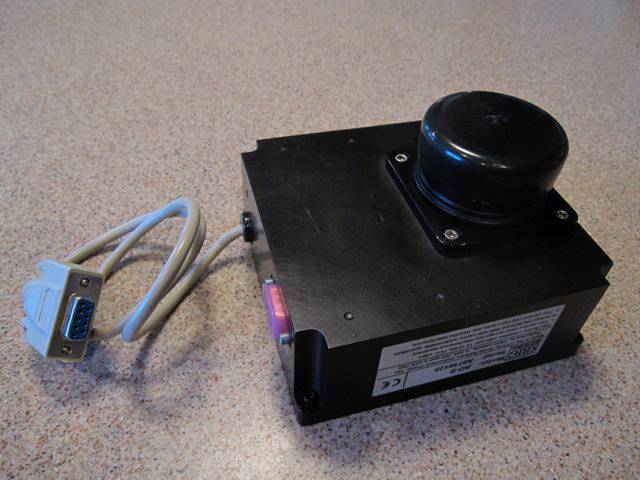 |
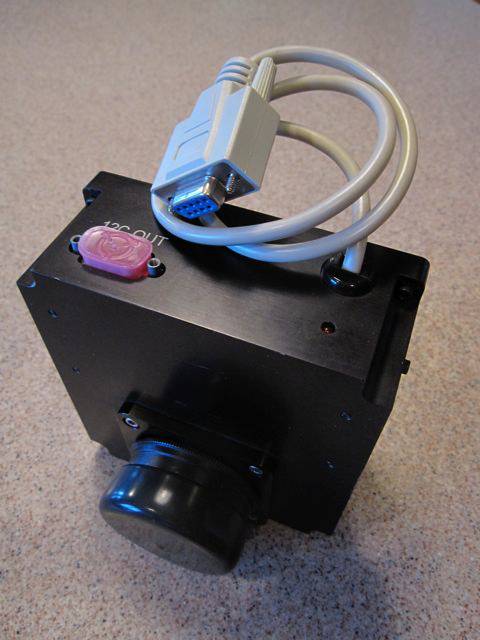 | The cable coming out of the AO-8 connects directly to the ST-4000XCM camera. The AO-8 uses a fine motion system to move a pellicle (thin optical element) that slightly refracts the entire image, resulting in shifting the position of the image, which is the same as shifting the aim point of the scope. This is a similar concept to motion stabilization systems in small cameras and some DSLR camera lenses. |
The image to the right shows the ST-4000XCM with AO-8 mounted on the front connected to the Pyxis rotator, which is mounted to the back of the 12" LX200R scope. | 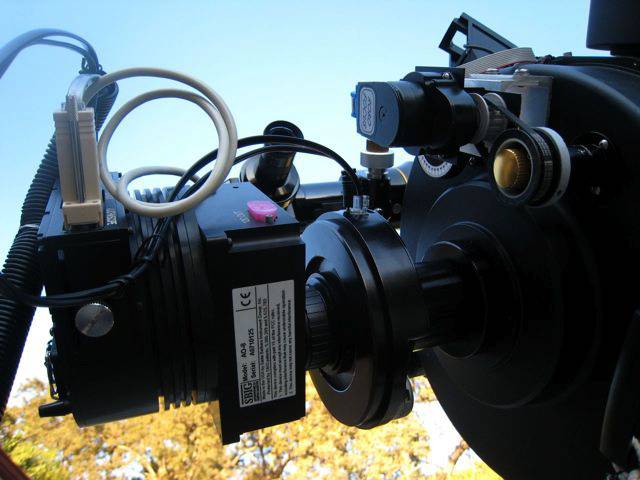 |
SBIG ST-4000XCM one-shot color astronomical CCD camera using KAI-4022 description specifications for observatory astro-imaging